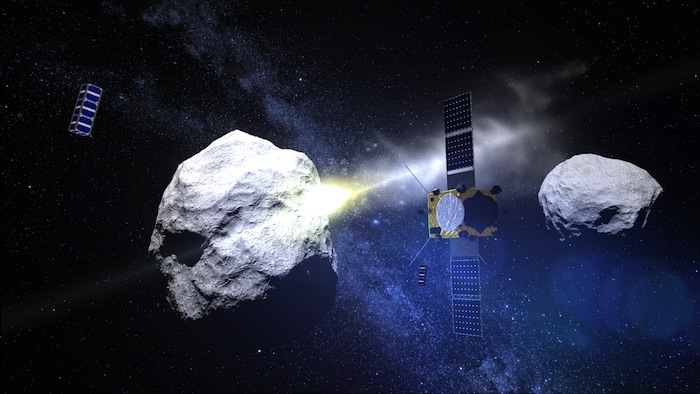The Institute of Space Sciences (IEEC-CSIC), shortlisted in the COPINS program of CubeSats [NOT TRANSLATED]

The mission shall be accompanied by two CubeSat, a nano- rectangular prism of 10 cm high and 30 cm wide and long, and about 3 kg of wheight. These satellites would be deployed around the secondary asteroid in order to study and monitor the impact of DART on its surface. It pretends to quantify the deviation caused by the projectile orbit and study the chemical composition of the asteroid.
Image: ESA – ScienceOffice.org
For now, the ESA has chosen five international consortia projects, including the PALS project (Payload of Advanced Little Satellites) in which the Institute of Space Sciences (IEEC-CSIC) participates.
The Institute of Space Sciences (IEEC-CSIC), a key part of PALS
The Institute of Space Sciences, joint center of the IEEC and CSIC, has presented its proposal in conjunction with the Swedish Institute of Space Physics (IRFU), the Royal Institute of Technology (KTH) and the company AAC Microtec, both also of Sweden, and the German aerospace Center DLR. Precisely Dr. Josep M. Trigo, head of the research group on Meteorites, small bodies and planetary sciences at ICE (IEEC-CSIC) is co-principal investigator in the scientific proposal of PALS, while Ivan Lloro from the research group on Astronomy of gravitational wawes at ICE (IEEC-CSIC), participates in the mission analysis and instrumentation design.
The PALS project includes two nano-satellites to obtain data of the magnetization of the asteroid, high resolution images and a study of the chemical composition and temperature reached by the substances that would result from the impact. This key information would be obtained through a sequential study of the impact, and the incandescent material steam plume emitted with, a high-resolution video spectrometer. The ICE (IEEC-CSIC) will contribute two main instruments: the video camera and spectrometer.
Now shortlisted projects will be supported by ESA for further study, and the final selection will be resolved in June next year.
You can find more information about the mission and this project in this video. [NOT TRANSLATED]
